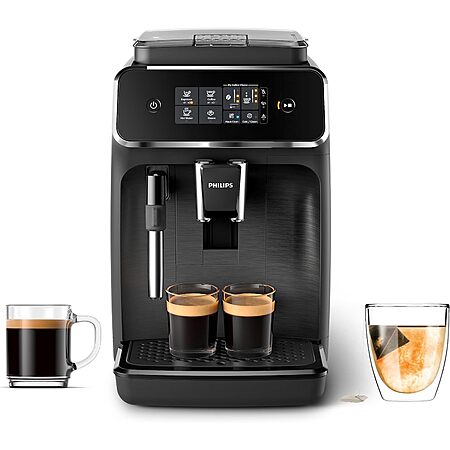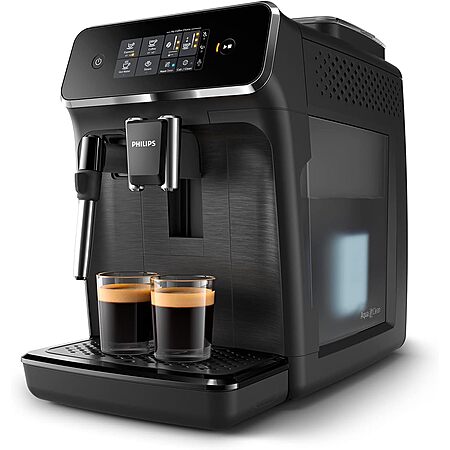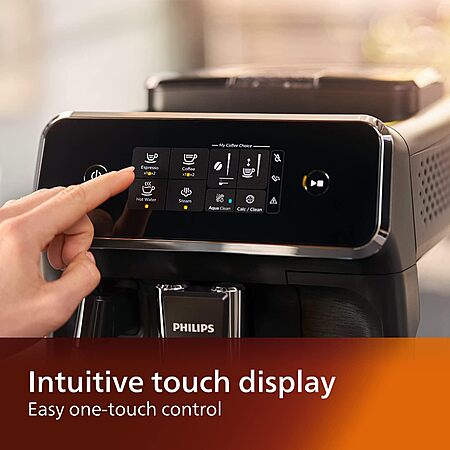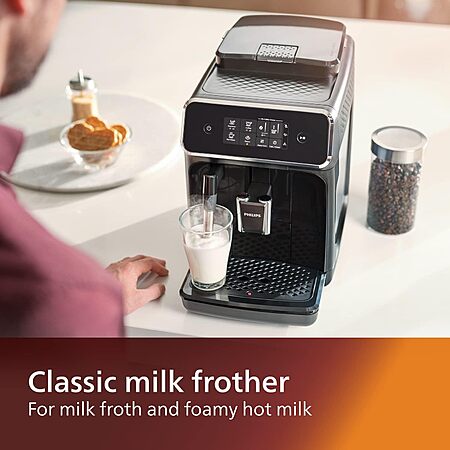expireddcpoor posted Nov 17, 2023 09:32 AM
Item 1 of 5
Item 1 of 5
expireddcpoor posted Nov 17, 2023 09:32 AM
PHILIPS 2200 Series Fully Automatic Espresso Machine - Classic Milk Frother - Amazon $349.00
$349
$650
46% offAmazon
Visit AmazonGood Deal
Bad Deal
Save
Share









Leave a Comment
22 Comments
Sign up for a Slickdeals account to remove this ad.
Sign up for a Slickdeals account to remove this ad.
Our community has rated this post as helpful. If you agree, why not thank overzeetop
I believe you're thinking of Westinghouse, Kodak, and the like. Philips is still a large, active multi-national corporation which owns quite a few brands. They have taken over and/or co-opted other brands as their own. This Philips espresso superautomatic gets a good deal of its design from Saeco. The professional side of Saeco (including Gaggia machines, I think) was recently sold off to a third party.
As to this deal. The internal coffee making parts are identical up and down this line, from the 2xxx series up to the 5xxx series. Spending more money gets you more or varied programs with the top levels allowing storable presets. The actual espresso maker mechanism and grinder is, afaik, identical - which means you're getting the same coffee results regardless of how much you spend.
The LatteGo is an autofoamer that works, but unless your every day drink is a Latte and you're up for cleaning out that milk container every couple days, it's just not worth it. A single latte of milk (with no coffee) and 30g of chocolate syrup makes a killer hot chocolate, but you'll have to sir it up yourself and use the annoying manual coffee cycle. If I had the manual frother I could just froth up a hot chocolate faster and not need to stir it up at the end. Your enjoyment of the magical auto-froth may vary. ;-)
Finally, the espresso this machine produces is thin and weak. That doesn't mean its bad, it's just not quite espresso. The grinder does not grind fine enough and the dose:water ratio is off by about a factor of 2-3, with the lower end resulting from a short duration pull. Specifically, a double shot of real espresso should be produced at ~9bar pressure through a compressed puck of ~17g of coffee over 30 seconds to produce a 32-35g (double) shot.
The Philips will extract 35-50g (depending on setting) per cycle using roughly 7g of coffee and take 12-20 seconds. It will look like espresso and taste like espresso but will be a little "thinner" than a proper pull. I've used an espresso-quality grinder (much finer than the finest grind possible with the Philips) and up to 9g of coffee (about 1.4x the recommended volume for a manual grind) to produce a very passable - I'd even say tasty - 28-30g of espresso.
I find the coffee and americanos produced are probably a 6 or 7 out of 10. Not as good as a good auto drip or V60, but better than most office or restaurant coffee. The hot water is convenient but slow, and comes out a different spigot - which is a good thing when you want it for tea.
Despite all of the warnings above, I'm reasonably happy with mine. I wish I'd saved the money and gotten the 2200 with the manual frother for $300 cheaper, but for my daily caffeine consumption it's more convenient and easy than any other method.
EDIT: Ill throw this out there - if you get one and have a really good grinder you want to do manual(-ish) shots with, and you have a 3D printer, DM me and I'll send you a file for a dosing funnel. The actual place you put pre-ground coffee is right above the chamber and it gets super steamy in operation, leading to condensation on the walls of the chute and then your grinds get stuck to the walls. This is both messy/difficult to clean and also cheats your dose. I designed a funnel that can be printed in vase mode which extends down to near the bottom of the chute and lets you funnel your grounds past all the condensation. It's a little thing, but a nice convenience.
As to this deal. The internal coffee making parts are identical up and down this line, from the 2xxx series up to the 5xxx series. Spending more money gets you more or varied programs with the top levels allowing storable presets. The actual espresso maker mechanism and grinder is, afaik, identical - which means you're getting the same coffee results regardless of how much you spend.
The LatteGo is an autofoamer that works, but unless your every day drink is a Latte and you're up for cleaning out that milk container every couple days, it's just not worth it. A single latte of milk (with no coffee) and 30g of chocolate syrup makes a killer hot chocolate, but you'll have to sir it up yourself and use the annoying manual coffee cycle. If I had the manual frother I could just froth up a hot chocolate faster and not need to stir it up at the end. Your enjoyment of the magical auto-froth may vary. ;-)
Finally, the espresso this machine produces is thin and weak. That doesn't mean its bad, it's just not quite espresso. The grinder does not grind fine enough and the dose:water ratio is off by about a factor of 2-3, with the lower end resulting from a short duration pull. Specifically, a double shot of real espresso should be produced at ~9bar pressure through a compressed puck of ~17g of coffee over 30 seconds to produce a 32-35g (double) shot.
The Philips will extract 35-50g (depending on setting) per cycle using roughly 7g of coffee and take 12-20 seconds. It will look like espresso and taste like espresso but will be a little "thinner" than a proper pull. I've used an espresso-quality grinder (much finer than the finest grind possible with the Philips) and up to 9g of coffee (about 1.4x the recommended volume for a manual grind) to produce a very passable - I'd even say tasty - 28-30g of espresso.
I find the coffee and americanos produced are probably a 6 or 7 out of 10. Not as good as a good auto drip or V60, but better than most office or restaurant coffee. The hot water is convenient but slow, and comes out a different spigot - which is a good thing when you want it for tea.
Despite all of the warnings above, I'm reasonably happy with mine. I wish I'd saved the money and gotten the 2200 with the manual frother for $300 cheaper, but for my daily caffeine consumption it's more convenient and easy than any other method.
As to this deal. The internal coffee making parts are identical up and down this line, from the 2xxx series up to the 5xxx series. Spending more money gets you more or varied programs with the top levels allowing storable presets. The actual espresso maker mechanism and grinder is, afaik, identical - which means you're getting the same coffee results regardless of how much you spend.
The LatteGo is an autofoamer that works, but unless your every day drink is a Latte and you're up for cleaning out that milk container every couple days, it's just not worth it. A single latte of milk (with no coffee) and 30g of chocolate syrup makes a killer hot chocolate, but you'll have to sir it up yourself and use the annoying manual coffee cycle. If I had the manual frother I could just froth up a hot chocolate faster and not need to stir it up at the end. Your enjoyment of the magical auto-froth may vary. ;-)
Finally, the espresso this machine produces is thin and weak. That doesn't mean its bad, it's just not quite espresso. The grinder does not grind fine enough and the dose:water ratio is off by about a factor of 2-3, with the lower end resulting from a short duration pull. Specifically, a double shot of real espresso should be produced at ~9bar pressure through a compressed puck of ~17g of coffee over 30 seconds to produce a 32-35g (double) shot.
The Philips will extract 35-50g (depending on setting) per cycle using roughly 7g of coffee and take 12-20 seconds. It will look like espresso and taste like espresso but will be a little "thinner" than a proper pull. I've used an espresso-quality grinder (much finer than the finest grind possible with the Philips) and up to 9g of coffee (about 1.4x the recommended volume for a manual grind) to produce a very passable - I'd even say tasty - 28-30g of espresso.
I find the coffee and americanos produced are probably a 6 or 7 out of 10. Not as good as a good auto drip or V60, but better than most office or restaurant coffee. The hot water is convenient but slow, and comes out a different spigot - which is a good thing when you want it for tea.
Despite all of the warnings above, I'm reasonably happy with mine. I wish I'd saved the money and gotten the 2200 with the manual frother for $300 cheaper, but for my daily caffeine consumption it's more convenient and easy than any other method.
Sign up for a Slickdeals account to remove this ad.
As to this deal. The internal coffee making parts are identical up and down this line, from the 2xxx series up to the 5xxx series. Spending more money gets you more or varied programs with the top levels allowing storable presets. The actual espresso maker mechanism and grinder is, afaik, identical - which means you're getting the same coffee results regardless of how much you spend.
The LatteGo is an autofoamer that works, but unless your every day drink is a Latte and you're up for cleaning out that milk container every couple days, it's just not worth it. A single latte of milk (with no coffee) and 30g of chocolate syrup makes a killer hot chocolate, but you'll have to sir it up yourself and use the annoying manual coffee cycle. If I had the manual frother I could just froth up a hot chocolate faster and not need to stir it up at the end. Your enjoyment of the magical auto-froth may vary. ;-)
Finally, the espresso this machine produces is thin and weak. That doesn't mean its bad, it's just not quite espresso. The grinder does not grind fine enough and the dose:water ratio is off by about a factor of 2-3, with the lower end resulting from a short duration pull. Specifically, a double shot of real espresso should be produced at ~9bar pressure through a compressed puck of ~17g of coffee over 30 seconds to produce a 32-35g (double) shot.
The Philips will extract 35-50g (depending on setting) per cycle using roughly 7g of coffee and take 12-20 seconds. It will look like espresso and taste like espresso but will be a little "thinner" than a proper pull. I've used an espresso-quality grinder (much finer than the finest grind possible with the Philips) and up to 9g of coffee (about 1.4x the recommended volume for a manual grind) to produce a very passable - I'd even say tasty - 28-30g of espresso.
I find the coffee and americanos produced are probably a 6 or 7 out of 10. Not as good as a good auto drip or V60, but better than most office or restaurant coffee. The hot water is convenient but slow, and comes out a different spigot - which is a good thing when you want it for tea.
Despite all of the warnings above, I'm reasonably happy with mine. I wish I'd saved the money and gotten the 2200 with the manual frother for $300 cheaper, but for my daily caffeine consumption it's more convenient and easy than any other method.
Leave a Comment